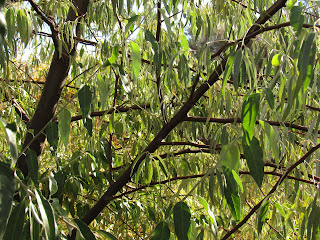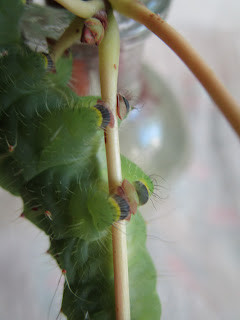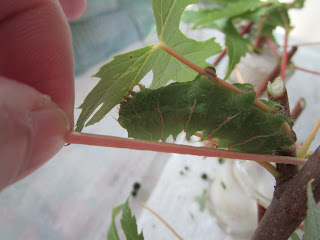September 26, Charlie and Alpha pulled together leaves and started their cocoons. A cocoon is the silk webbing that helps protect the inner pupa where the moth or butterfly go through their last change. some butterflies use silk to hang upside down before they make their final molt. Often, the pupa of this particular moth rattles inside the silk wrapped leaves when shaken and the sticks and leaves have been harvested as rattles. I just left them alone in a protected area. Since in a normal environment they are snowed on, frozen, and subjected to all kinds of weather, I put the two containers of cocoons inside an unheated building.
September 28. Pee Wee, as mentioned before was quite a bit smaller. However, a day or two later, even this last caterpillar wrapped up for a long winter's nap.


As easy as it was to raise the caterpillars, it wasn't as simple as it might be. First, we had no idea if the eggs laid were fertile. Then, the instars needed fed and their container cleaned. Thankfully, there are many blogs out there and after trial and error, I learned a few things. The tiny first stages are best gently picked up with the clean bristles of a paintbrush; you MUST keep a fine mesh fabric over the container because they climb and can escape; the branches and leaves need examined carefully to ensure you don't toss out the babies with the debris; and those leaves and branches need to be kept green. The latter is the most challenging. Sticking a branch in a glass isn't efficient because the caterpillars will drown. The best ways I found included getting floral picks from a craft store and putting stems inside tiny containers stuffed full of wet cotton balls with cling plastic and tape over the top. The floral picks worked well, but together the stems and branches had the best chances of staying green longer. It was also easier when removing the debris if there was an upright branch the caterpillars could stay on while being outside the container. No matter how large they are, they are still fairly fragile and accidentally dropping one would not be kind. The food was another frustrating thing, I've mentioned that in previous posts. Many of the large leaf maples were just too high off the ground for me to pick and I wish they'd have preferred a more easily obtained leaf! They also needed very lightly spritzed now and then with sterile water when they are in later instar stages. Because house caterpillars don't get rained on! For much of their lives, I used a plastic terrarium container for ease in cleaning. The caterpillars need warm temps to thrive, yet not too hot, because humidity in their containers can kill them. Another super important thing you should remember is household cleaning supplies. Chemicals can and will kill caterpillars and most any insect if they breathe it. Several persons who raise butterflies and moths stress the importance of not using these. You don't want to go through weeks of raising instars and lose them all to a bout of cleaning with bleach or carpet cleaners. Even if you are in a different room, air ducts move odors all over.
Later, after Charlie and Alpha built their winter homes, they were moved into a mesh enclosure. Pee Wee was left in the plastic container. If all three enclosed, that would make a LOT of wings in one spot and I wanted to give them some room. Sometimes caterpillars can have tiny black dots on their bodies. Thankfully, none of these had any. Those dots are actually from an insect that has laid eggs inside the body of the caterpillar. When the cocoon is made, the eggs hatch and eat the caterpillar goo. So, you get a swarm of tiny good yard bugs instead of a stunning large moth!!! Many places silk moths will brood twice a season. Here in the PNW, they only breed once. Polyphemus moths are usually found in our area around late June to late July. Since Jon had found the parent female on July 21, '21, we knew there would be a bit of a wait. Because the pupa inside the cocoons can dehydrate, once in a while, I did spritz the leaves around the cocoons, but for the most part, just kept an eye on them. Keeping an eye on them is super important. Caterpillars in inside cocoons, if kept too warm, can emerge much too early. Some people have had them emerge in February and all you can do is enjoy them inside until they die.
Overall, the best part about human ecosystems is that as cocoons, they won't be eaten by squirrels, mice, or woodpeckers and as caterpillars, some just might end up surviving to reproduce.





















































